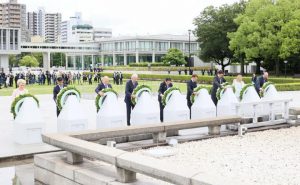Striving to fill voids in Hiroshima, unfinished judgment, Part 15: Meaning for the world
May 7, 2024
Warning bell to prevent devastation from nuclear war
by Kyosuke Mizukawa, Senior Staff Writer
On May 19 last year, the summit meeting of the G7 (Group of Seven industrialized nations) began in Hiroshima City. The leaders of all seven nations visited the Hiroshima Peace Memorial Museum in Peace Memorial Park, located in the city’s Naka Ward, and laid wreaths of flowers at the Cenotaph for the A-bomb Victims. Among the seven nations, the United States, which dropped the atomic bombs on Japan, the United Kingdom, and France possess nuclear weapons, while the remaining four countries, including Japan, rely on nuclear deterrence provided by the United States.
The death toll from the atomic bombing that indiscriminately decimated Hiroshima was estimated to have been 140,000 (±10,000) people by the end of December 1945. The effects from radiation has led to an increase in incidences of leukemia and cancers, resulting in suffering among A-bomb survivors. The visit to Hiroshima by the leaders provided them an opportunity to come into contact with the A-bombing’s devastating consequences, which served as the foundation for the ruling in the “A-bomb trial” that the dropping of the atomic bombs was a violation of international law.
No mention of illegality
The “Hiroshima Vision,” a statement of nuclear disarmament compiled by the G7 leaders, affirmed that “a nuclear war … must never be fought.” However, the statement failed to mention either the illegality of the atomic bombings or the Treaty on the Prohibition of Nuclear Weapons (TPNW). Although the vision statement made an appeal that the threat or use of nuclear weapons by Russia, in the context of Russia’s invasion of Ukraine, would be unforgiveable, it also spelled out that nuclear weapons “should serve defensive purposes,” phrasing that seemed to ignore the possession of nuclear weapons by the United States, the United Kingdom, and France.
The text of the Hiroshima Vision was probably far removed from the ideas of Shoichi Okamoto, an attorney who advocated for the A-bomb trial with the aim of banning the use of atomic bombs 70 years before the Hiroshima Vision was issued. Mr. Okamoto wrote a poem that expressed the underlying feelings that led him to pour his heart and soul into pursuing the responsibility for the atomic bombings.
“Humanity always claims it will not wage destructive war, yet it does again. How pitiful humanity is!”
All the while pledging to never again wage war, bringing about great devastation, humanity repeatedly ends up doing so. That same humanity has entered a time in which it can annihilate itself in a nuclear war. Because the mere verbal promise never to wage war cannot prevent it from happening at some time, the A-bomb trial was an attempt to etch into history that the atomic bombings represented a mistake in violation of international law and to prevent the world’s ruin with use of the power of law on the basis of that reasoning.
Justifying Gaza attack
A-bomb survivors themselves participated in the trial as plaintiffs. Through the pursuit of the law by legal scholars and judges, the case resulted in a court ruling that the atomic bombings of Hiroshima and Nagasaki had indeed violated international law. How humanity decides to face this ruling, the first and still considered the only such judgment in the world, will affect the world now and into the future.
Israel, for example, continues to attack the Palestinian-controlled Gaza strip. According to a U.S. media report in October last year, Israeli government officials justified to U.S. officials the damage to civilians brought about by the attacks by citing America’s atomic bombings of Japan. Should the U.S. atomic bombings be considered legal and justifiable, that could also provide a reasonable excuse for Russia and other nuclear powers to use nuclear weapons.
To break this negative chain reaction, former Hiroshima City Mayor Takashi Hiraoka, 96, has insisted that the responsibility for the atomic bombings should continue being questioned. As a starting point for citizens to think about this issue, Mr. Hiraoka sincerely hopes people will know about the A-bomb trial.
The ruling of the A-bomb trial was a warning bell for the need to prevent the destruction of humanity. Our efforts to pass on the ruling are called into question.
Keywords
G7 Hiroshima Summit
The summit meeting was held in Hiroshima City during the period May 19–21, 2023. It was attended by the leaders of the seven industrialized nations, including the three nuclear weapons states of the United States, the United Kingdom, and France, as well as the European Union (EU), and presided over by Japan’s Prime Minister Fumio Kishida. On the first day of the meeting, the leaders together visited Peace Memorial Park, located in the city’s Naka Ward, and toured the Hiroshima Peace Memorial Museum, where they met with an A-bomb survivor. They then laid wreaths of flowers at the Cenotaph for the A-bomb Victims and viewed the A-bomb Dome. That was the same day the Hiroshima Vision, the first agreement specifically focused on nuclear disarmament, was compiled.
(Originally published on May 7, 2024)








